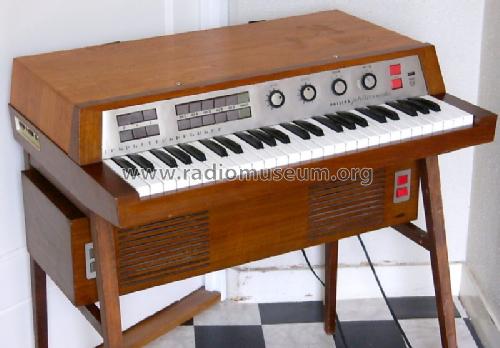Yesterday a friend of mine dropped by with an old Philips made Philicorda organ which I revised a while ago. One of the keys had the plastic part in the mechanism that kept it at the right height snapped off.
 This Combo organ was built between 1961-63 and was the very first version of the Philicorda, so the plastics used have become quite brittle.
This Combo organ was built between 1961-63 and was the very first version of the Philicorda, so the plastics used have become quite brittle. |
| The brittle plastic part that hold the keys at the right height |
I happened to have the 2nd version of the Philicorda, a 1966 or '67 GM-751, which is in pretty bad shape, so I will use this one for spare parts and try to find one in better shape for actual use. Luckily the key-mechanisms are the same on both versions so I could salvage the plastic bits to repair the AG-7500.
 |
| After the fix |
These are really lovely instruments. I have known about philicorda's all my life and here in The Netherlands you run into them all the time, and I always considered them quite cheesy sounding instruments. However, version 1 and 2 are very different from later models. Other than the later models, these are fully loaded with tubes and what I think are neon lamps that make this thing glow like a christmas-tree, and they have a really nice raw sound to them. Also they are loaded with enough Philips mustard caps to make vintage Marshall owners green with envy.
 |
| Lots of neon lamps and Philips mustard caps |
These organs came with their own tube amp/speaker combo which was mounted on it wooden stand.
They had a phono-input for playing along with the rhythm-tracks on vinyl that Philips made for these organs!
In recent years people seem to have rediscovered these instruments and prizes have gone up quite a bit. You can see the sturdier GM-751 being used on stage by a lot of Dutch bands at the moment, one of my favorites being The Swains, which are from my hometown; Groningen.
http://the-swains.blogspot.nl/
http://youtu.be/QkXYXqpO92I
Here is an example of the GM-7500;
How to replace a key on the AG7500/GM-751
I have been contacted by someone looking for a replacement F#key for his GM-751 and promised him to write a little tutorial on how to replace them, so I figured I should add this to this post in case more people are searching for this information.On the underside of the cabinet there is a piece of board protecting the key-lock mechanism and part of a circuit-board. If you remove the screws at the front edge of the board you can slide and lift it from the cabinet. You will need access to the key-lock mechanisms later.
Next you need to remove the lid, which is basically the whole enclosure. To do this you will need to remove two screws on either side, circled red on this picture;
Lift the lid, disconnect the wires from the speakers and remove the lid;
The panel that carries the knobs and switches needs to be removed by removing the two screws (circled red here) on either side, the cables connected are long enough to lift the panel a few inches so you can remove the keys. The screws for removing the panel on the AG-7500 are located directly below it at the underside of the cabinet and these have only one screw on either side;
I don't know the proper name of these plastic parts that hold down the keys, so I will just call them key-locks;
These key-locks are held in place a metal axle that also holds the spring. They come out underneath the cabinet held by plastic hexagons;
Use a screwdriver to turn the axle a quarter of a circle so the key-locks are parallel to the keys;
You can now lift the front part of the key;
The back of the key is secured by a plastic part (circled red) that's locked inside an aluminum rail. Don't try to remove the key by squeezing the part circled in orange. I tried, and it snapped.
I feared I needed to slide out every key sideways down the rail until I got to the one I needed, but luckily you can just wiggle and pull the key upwards and it will come out of the rail;
Voila!;
When putting in the replacement key make sure the key-lock is facing in this direction and once the key is in place turn the axle a quarter of a circle to lock the key in place;

















Oanatlia_zu-Des Moines Allison Reed https://wakelet.com/wake/38svWtMguLXlJKqIUcL6E
ReplyDeletebrilbuledoors
momosusto-Sioux Falls Melinda Khan Cinema 4D
ReplyDeleteWinZip
Winamp Pro
pecttunavi